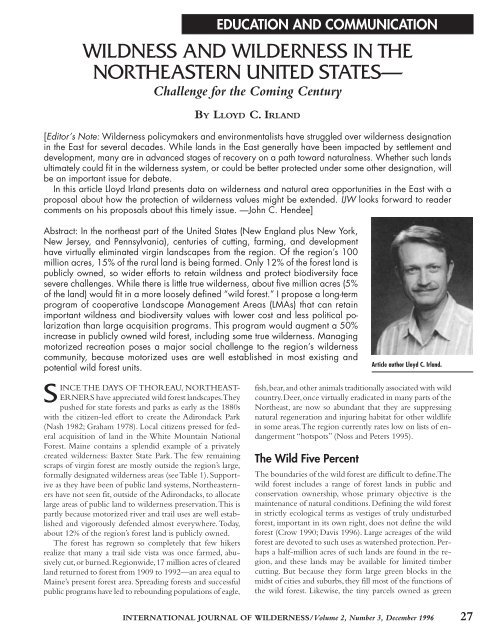P3-Vol 2.No3 Dec 96 - International Journal of Wilderness
P3-Vol 2.No3 Dec 96 - International Journal of Wilderness
P3-Vol 2.No3 Dec 96 - International Journal of Wilderness
You also want an ePaper? Increase the reach of your titles
YUMPU automatically turns print PDFs into web optimized ePapers that Google loves.
EDUCATION AND COMMUNICATION<br />
WILDNESS AND WILDERNESS IN THE<br />
NORTHEASTERN UNITED STATES—<br />
Challenge for the Coming Century<br />
BY LLOYD C. IRLAND<br />
[Editor’s Note: <strong>Wilderness</strong> policymakers and environmentalists have struggled over wilderness designation<br />
in the East for several decades. While lands in the East generally have been impacted by settlement and<br />
development, many are in advanced stages <strong>of</strong> recovery on a path toward naturalness. Whether such lands<br />
ultimately could fit in the wilderness system, or could be better protected under some other designation, will<br />
be an important issue for debate.<br />
In this article Lloyd Irland presents data on wilderness and natural area opportunities in the East with a<br />
proposal about how the protection <strong>of</strong> wilderness values might be extended. IJW looks forward to reader<br />
comments on his proposals about this timely issue. —John C. Hendee]<br />
Abstract: In the northeast part <strong>of</strong> the United States (New England plus New York,<br />
New Jersey, and Pennsylvania), centuries <strong>of</strong> cutting, farming, and development<br />
have virtually eliminated virgin landscapes from the region. Of the region’s 100<br />
million acres, 15% <strong>of</strong> the rural land is being farmed. Only 12% <strong>of</strong> the forest land is<br />
publicly owned, so wider efforts to retain wildness and protect biodiversity face<br />
severe challenges. While there is little true wilderness, about five million acres (5%<br />
<strong>of</strong> the land) would fit in a more loosely defined “wild forest.” I propose a long-term<br />
program <strong>of</strong> cooperative Landscape Management Areas (LMAs) that can retain<br />
important wildness and biodiversity values with lower cost and less political polarization<br />
than large acquisition programs. This program would augment a 50%<br />
increase in publicly owned wild forest, including some true wilderness. Managing<br />
motorized recreation poses a major social challenge to the region’s wilderness<br />
community, because motorized uses are well established in most existing and<br />
potential wild forest units.<br />
S<br />
INCE THE DAYS OF THOREAU, NORTHEAST-<br />
ERNERS have appreciated wild forest landscapes. They<br />
pushed for state forests and parks as early as the 1880s<br />
with the citizen-led effort to create the Adirondack Park<br />
(Nash 1982; Graham 1978). Local citizens pressed for federal<br />
acquisition <strong>of</strong> land in the White Mountain National<br />
Forest. Maine contains a splendid example <strong>of</strong> a privately<br />
created wilderness: Baxter State Park. The few remaining<br />
scraps <strong>of</strong> virgin forest are mostly outside the region’s large,<br />
formally designated wilderness areas (see Table 1). Supportive<br />
as they have been <strong>of</strong> public land systems, Northeasterners<br />
have not seen fit, outside <strong>of</strong> the Adirondacks, to allocate<br />
large areas <strong>of</strong> public land to wilderness preservation. This is<br />
partly because motorized river and trail uses are well established<br />
and vigorously defended almost everywhere. Today,<br />
about 12% <strong>of</strong> the region’s forest land is publicly owned.<br />
The forest has regrown so completely that few hikers<br />
realize that many a trail side vista was once farmed, abusively<br />
cut, or burned. Regionwide, 17 million acres <strong>of</strong> cleared<br />
land returned to forest from 1909 to 1992—an area equal to<br />
Maine’s present forest area. Spreading forests and successful<br />
public programs have led to rebounding populations <strong>of</strong> eagle,<br />
Article author Lloyd C. Irland.<br />
fish, bear, and other animals traditionally associated with wild<br />
country. Deer, once virtually eradicated in many parts <strong>of</strong> the<br />
Northeast, are now so abundant that they are suppressing<br />
natural regeneration and injuring habitat for other wildlife<br />
in some areas. The region currently rates low on lists <strong>of</strong> endangerment<br />
“hotspots” (Noss and Peters 1995).<br />
The Wild Five Percent<br />
The boundaries <strong>of</strong> the wild forest are difficult to define. The<br />
wild forest includes a range <strong>of</strong> forest lands in public and<br />
conservation ownership, whose primary objective is the<br />
maintenance <strong>of</strong> natural conditions. Defining the wild forest<br />
in strictly ecological terms as vestiges <strong>of</strong> truly undisturbed<br />
forest, important in its own right, does not define the wild<br />
forest (Crow 1990; Davis 19<strong>96</strong>). Large acreages <strong>of</strong> the wild<br />
forest are devoted to such uses as watershed protection. Perhaps<br />
a half-million acres <strong>of</strong> such lands are found in the region,<br />
and these lands may be available for limited timber<br />
cutting. But because they form large green blocks in the<br />
midst <strong>of</strong> cities and suburbs, they fill most <strong>of</strong> the functions <strong>of</strong><br />
the wild forest. Likewise, the tiny parcels owned as green<br />
INTERNATIONAL JOURNAL OF WILDERNESS/<strong>Vol</strong>ume 2, Number 3, <strong>Dec</strong>ember 19<strong>96</strong> 27










